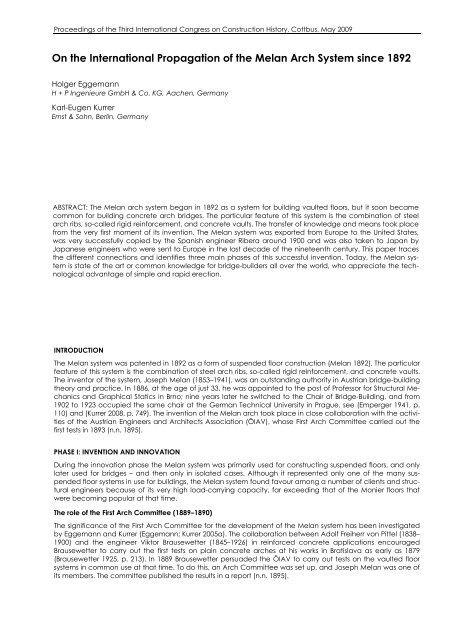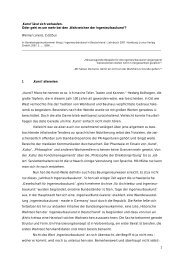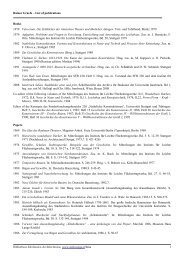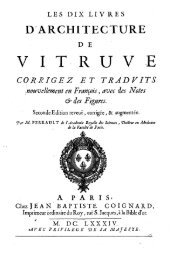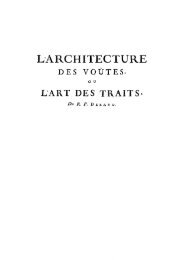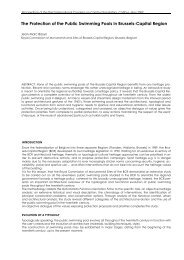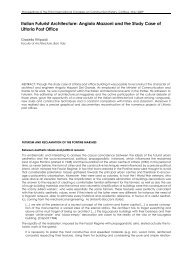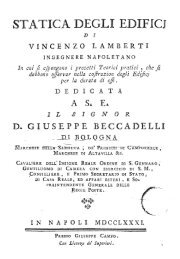On the International Propagation of the Melan Arch System since 1892
On the International Propagation of the Melan Arch System since 1892
On the International Propagation of the Melan Arch System since 1892
Create successful ePaper yourself
Turn your PDF publications into a flip-book with our unique Google optimized e-Paper software.
Proceedings <strong>of</strong> <strong>the</strong> Third <strong>International</strong> Congress on Construction History, Cottbus, May 2009<br />
<strong>On</strong> <strong>the</strong> <strong>International</strong> <strong>Propagation</strong> <strong>of</strong> <strong>the</strong> <strong>Melan</strong> <strong>Arch</strong> <strong>System</strong> <strong>since</strong> <strong>1892</strong><br />
Holger Eggemann<br />
H + P Ingenieure GmbH & Co. KG, Aachen, Germany<br />
Karl-Eugen Kurrer<br />
Ernst & Sohn, Berlin, Germany<br />
ABSTRACT: The <strong>Melan</strong> arch system began in <strong>1892</strong> as a system for building vaulted floors, but it soon became<br />
common for building concrete arch bridges. The particular feature <strong>of</strong> this system is <strong>the</strong> combination <strong>of</strong> steel<br />
arch ribs, so-called rigid reinforcement, and concrete vaults. The transfer <strong>of</strong> knowledge and means took place<br />
from <strong>the</strong> very first moment <strong>of</strong> its invention. The <strong>Melan</strong> system was exported from Europe to <strong>the</strong> United States,<br />
was very successfully copied by <strong>the</strong> Spanish engineer Ribera around 1900 and was also taken to Japan by<br />
Japanese engineers who were sent to Europe in <strong>the</strong> last decade <strong>of</strong> <strong>the</strong> nineteenth century. This paper traces<br />
<strong>the</strong> different connections and identifies three main phases <strong>of</strong> this successful invention. Today, <strong>the</strong> <strong>Melan</strong> system<br />
is state <strong>of</strong> <strong>the</strong> art or common knowledge for bridge-builders all over <strong>the</strong> world, who appreciate <strong>the</strong> technological<br />
advantage <strong>of</strong> simple and rapid erection.<br />
INTRODUCTION<br />
The <strong>Melan</strong> system was patented in <strong>1892</strong> as a form <strong>of</strong> suspended floor construction (<strong>Melan</strong> <strong>1892</strong>). The particular<br />
feature <strong>of</strong> this system is <strong>the</strong> combination <strong>of</strong> steel arch ribs, so-called rigid reinforcement, and concrete vaults.<br />
The inventor <strong>of</strong> <strong>the</strong> system, Joseph <strong>Melan</strong> (1853–1941), was an outstanding authority in Austrian bridge-building<br />
<strong>the</strong>ory and practice. In 1886, at <strong>the</strong> age <strong>of</strong> just 33, he was appointed to <strong>the</strong> post <strong>of</strong> Pr<strong>of</strong>essor for Structural Mechanics<br />
and Graphical Statics in Brno; nine years later he switched to <strong>the</strong> Chair <strong>of</strong> Bridge-Building, and from<br />
1902 to 1923 occupied <strong>the</strong> same chair at <strong>the</strong> German Technical University in Prague, see (Emperger 1941, p.<br />
110) and (Kurrer 2008, p. 749). The invention <strong>of</strong> <strong>the</strong> <strong>Melan</strong> arch took place in close collaboration with <strong>the</strong> activities<br />
<strong>of</strong> <strong>the</strong> Austrian Engineers and <strong>Arch</strong>itects Association (ÖIAV), whose First <strong>Arch</strong> Committee carried out <strong>the</strong><br />
first tests in 1893 (n.n. 1895).<br />
PHASE I: INVENTION AND INNOVATION<br />
During <strong>the</strong> innovation phase <strong>the</strong> <strong>Melan</strong> system was primarily used for constructing suspended floors, and only<br />
later used for bridges – and <strong>the</strong>n only in isolated cases. Although it represented only one <strong>of</strong> <strong>the</strong> many suspended<br />
floor systems in use for buildings, <strong>the</strong> <strong>Melan</strong> system found favour among a number <strong>of</strong> clients and structural<br />
engineers because <strong>of</strong> its very high load-carrying capacity, far exceeding that <strong>of</strong> <strong>the</strong> Monier floors that<br />
were becoming popular at that time.<br />
The role <strong>of</strong> <strong>the</strong> First <strong>Arch</strong> Committee (1889–1890)<br />
The significance <strong>of</strong> <strong>the</strong> First <strong>Arch</strong> Committee for <strong>the</strong> development <strong>of</strong> <strong>the</strong> <strong>Melan</strong> system has been investigated<br />
by Eggemann and Kurrer (Eggemann; Kurrer 2005a). The collaboration between Adolf Freiherr von Pittel (1838–<br />
1900) and <strong>the</strong> engineer Viktor Brausewetter (1845–1926) in reinforced concrete applications encouraged<br />
Brausewetter to carry out <strong>the</strong> first tests on plain concrete arches at his works in Bratislava as early as 1879<br />
(Brausewetter 1925, p. 213). In 1889 Brausewetter persuaded <strong>the</strong> ÖIAV to carry out tests on <strong>the</strong> vaulted floor<br />
systems in common use at that time. To do this, an <strong>Arch</strong> Committee was set up, and Joseph <strong>Melan</strong> was one <strong>of</strong><br />
its members. The committee published <strong>the</strong> results in a report (n.n. 1895).
<strong>Melan</strong>’s Patent<br />
Proceedings <strong>of</strong> <strong>the</strong> Third <strong>International</strong> Congress on Construction History, May 2009<br />
Motivated by his work on <strong>the</strong> <strong>Arch</strong> Committee, <strong>Melan</strong> submitted a patent application to <strong>the</strong> governing authorities<br />
in Brno on 20 December 1891: “A new type <strong>of</strong> floor construction essentially consisting <strong>of</strong> <strong>the</strong> combination<br />
<strong>of</strong> iron arch ribs and concrete vaults” (<strong>Melan</strong> <strong>1892</strong>). “The essence <strong>of</strong> <strong>the</strong> floor construction consists ... <strong>of</strong> <strong>the</strong><br />
combination <strong>of</strong> iron arch ribs and a concrete vault, with <strong>the</strong> latter being properly reinforced. This reinforcement<br />
is <strong>the</strong>n especially important when a non-uniformly distributed load on <strong>the</strong> floor would cause tensile<br />
stresses ... Fur<strong>the</strong>r, <strong>the</strong> arch ribs enable a simple fixing <strong>of</strong> <strong>the</strong> shuttering timbers for casting <strong>the</strong> concrete vault,<br />
so a special scaffolding is totally unnecessary, even for longer spans” (<strong>Melan</strong> <strong>1892</strong>). Fig. 1 shows <strong>the</strong> most important<br />
constructional details <strong>of</strong> <strong>Melan</strong>’s suspended floor system. The patent application already embodied all<br />
<strong>the</strong> advantages that would emerge in <strong>the</strong> floor’s fur<strong>the</strong>r development into <strong>the</strong> <strong>Melan</strong> system (at <strong>the</strong> end <strong>of</strong> <strong>the</strong><br />
innovation phase) and prove <strong>the</strong>ir worth immediately in <strong>the</strong> building <strong>of</strong> reinforced concrete arch bridges<br />
(Brausewetter 1925, p. 250).<br />
<strong>On</strong>e test and <strong>the</strong> first structures<br />
During <strong>the</strong> summer <strong>of</strong> 1893 <strong>the</strong> Vault Committee carried out an additional test on a <strong>Melan</strong> arch. The test assembly<br />
could not be made to fail under a symmetrical loading, and it required an asymmetric loading to induce<br />
failure (Fig. 2). The arch according to <strong>the</strong> <strong>Melan</strong> system supported three to four times <strong>the</strong> loading <strong>of</strong> <strong>the</strong><br />
o<strong>the</strong>r test assemblies (n.n. 1895). This test earned <strong>the</strong> <strong>Melan</strong> system <strong>of</strong>ficial recognition; an important step on<br />
<strong>the</strong> path to fur<strong>the</strong>r applications had been taken.<br />
Figure 1 (left): Drawing from <strong>Melan</strong>’s patent; (<strong>Melan</strong> <strong>1892</strong>)<br />
Figure 2 (right): <strong>Melan</strong> arch after failure; (n.n. 1895)<br />
The collaboration between <strong>the</strong> engineering scientist Joseph <strong>Melan</strong> and <strong>the</strong> industrialist Viktor Brausewetter resulted<br />
in <strong>the</strong> use <strong>of</strong> <strong>Melan</strong> arches, first in buildings, later in bridges. As early as <strong>1892</strong>, Joseph <strong>Melan</strong> had assigned<br />
<strong>the</strong> licence for Austria-Hungary and Germany to Viktor Brausewetter. By 1894 <strong>the</strong> Pittel & Brausewetter<br />
company had erected 100 000 m² <strong>of</strong> <strong>Melan</strong> floors for factories and warehouses plus three smaller road bridges<br />
in Bohemia according to <strong>Melan</strong>’s patent (Emperger 1894, pp. 456-457).<br />
PHASE II: DIFFUSION<br />
The close ties between science and industry – represented here by Joseph <strong>Melan</strong> and Viktor Brausewetter –<br />
enabled <strong>Melan</strong>’s invention to be introduced into everyday building (innovation phase). However, <strong>the</strong> transition<br />
from <strong>the</strong> innovation to <strong>the</strong> diffusion <strong>of</strong> <strong>the</strong> <strong>Melan</strong> system throughout <strong>the</strong> European bridge-building market<br />
could not be completed without <strong>the</strong> endorsement <strong>of</strong> <strong>the</strong> authorities, which were normally involved in approving<br />
<strong>the</strong> building <strong>of</strong> larger bridges, plus corresponding standards for <strong>the</strong> calculations (Kurrer 2003). During <strong>the</strong><br />
innovation phase it was primarily <strong>the</strong> high load-carrying capacity <strong>of</strong> <strong>the</strong> <strong>Melan</strong> system, as an appealing structural/constructional<br />
criterion, that helped it to stand out against rival suspended floor systems. Now a technological<br />
criterion was added to this which made a decisive contribution to helping <strong>the</strong> <strong>Melan</strong> system gain acceptance<br />
in <strong>the</strong> bridge-building market: <strong>Melan</strong> bridges did not require any temporary works during<br />
construction. The USA <strong>the</strong>refore took <strong>the</strong> lead first in <strong>the</strong> building <strong>of</strong> <strong>Melan</strong> bridges; in Europe it was <strong>the</strong> Spanish<br />
bridge-building market where a variation <strong>of</strong> <strong>the</strong> <strong>Melan</strong> system became established. In <strong>the</strong> o<strong>the</strong>r European<br />
countries <strong>Melan</strong> bridges played only a subsidiary role. And <strong>the</strong> heyday <strong>of</strong> great reinforced concrete arch<br />
bridges in <strong>the</strong> 1930s plus <strong>the</strong> scarcity <strong>of</strong> steel for construction forced <strong>the</strong> <strong>Melan</strong> system into a hibernation from<br />
which it would not awake until <strong>the</strong> late 1970s.
Proceedings <strong>of</strong> <strong>the</strong> Third <strong>International</strong> Congress on Construction History, May 2009<br />
United States <strong>of</strong> America<br />
The <strong>Melan</strong> system spread quickly across <strong>the</strong> United States, where <strong>the</strong> use <strong>of</strong> reinforced concrete for bridges did<br />
not become established through <strong>the</strong> application <strong>of</strong> Joseph Monier’s patents, as in Europe, but ra<strong>the</strong>r via <strong>the</strong><br />
<strong>Melan</strong> system. According to Edwin Thacher, in <strong>the</strong> period between 1894 and 1904 some 300 <strong>Melan</strong> bridges<br />
were built in <strong>the</strong> USA by <strong>the</strong> New York Concrete-Steel Engineering Company alone, see (Thacher 1905, p. 53)<br />
and (Gasparini 2003, p. 332). Fritz von Emperger (1862–1942) and Edwin Thacher (1839–1920) were key figures in<br />
<strong>the</strong> early days <strong>of</strong> reinforced concrete construction in <strong>the</strong> USA. It was <strong>the</strong> Austrian civil engineer Emperger in<br />
particular who made a vital contribution to establishing <strong>the</strong> <strong>Melan</strong> system in <strong>the</strong> US bridge-building market<br />
(Emperger 1894). The construction history <strong>of</strong> <strong>the</strong> years 1894–1904 has also been investigated by Gasparini<br />
(Gasparini 2003), and Eggemann and Kurrer have thrown light on <strong>the</strong> fur<strong>the</strong>r developments (Eggemann; Kurrer<br />
2006). According to an estimate by Spangenberg, more than 5000 bridges had been built with rigid reinforcement<br />
in <strong>the</strong> USA by 1924 (Spangenberg 1925, p. 503). In <strong>the</strong> next years <strong>the</strong> application <strong>of</strong> <strong>the</strong> <strong>Melan</strong> system<br />
enjoyed its heyday worldwide; some <strong>of</strong> <strong>the</strong> concrete arch bridges that at <strong>the</strong> time <strong>of</strong> <strong>the</strong>ir completion<br />
were <strong>the</strong> longest in <strong>the</strong> world made use <strong>of</strong> rigid reinforcement. For example, <strong>the</strong> three arches <strong>of</strong> <strong>the</strong> F. W.<br />
Cappelen Memorial Bridge across <strong>the</strong> Mississippi in Minneapolis. The bridge was named after <strong>the</strong> first project<br />
engineer, Frederick William Cappelen, who died during <strong>the</strong> planning. The centre arch spans 122 m, which was<br />
a world record when <strong>the</strong> bridge was completed in 1923 (Fig. 3).<br />
Figure 3: F. W. Cappelen Memorial Bridge during construction;<br />
inset: <strong>the</strong> old bridge, <strong>the</strong> piers <strong>of</strong> which were retained; (n.n. 1923, fig. 4)<br />
<strong>Melan</strong> bridges in Austria and neighbouring countries<br />
Emperger wrote about his successes with <strong>the</strong> <strong>Melan</strong> system in <strong>the</strong> USA in <strong>the</strong> journal <strong>of</strong> <strong>the</strong> ÖIAV (Emperger<br />
1895; 1896) and <strong>the</strong>refore speeded up <strong>the</strong> establishment <strong>of</strong> <strong>the</strong> <strong>Melan</strong> system in Austria. <strong>Melan</strong> was <strong>the</strong> designer<br />
and Brausewetter <strong>the</strong> contractor for <strong>the</strong> first larger bridge in Austria, <strong>the</strong> Schwimmschul Bridge in Steyr<br />
with a span <strong>of</strong> 42 m, which was built in 1897/98 (Fig. 4). <strong>Melan</strong> completed numerous bridges toge<strong>the</strong>r with <strong>the</strong><br />
Pittel & Brausewetter company, e.g. in Ljubljana, Payerbach, Bielitz and Döberney (<strong>Melan</strong> 1911, Preface); in Italy<br />
bridges were built over <strong>the</strong> Polcevera near Genoa and over <strong>the</strong> Tagliamento near Pinzano (Spitzer; Nowak<br />
1908, p. 68f.). Eggemann and Kurrer have provided a detailed review <strong>of</strong> <strong>the</strong> developments in Austria (Eggemann;<br />
Kurrer 2005a). Bridges known to have been designed by <strong>Melan</strong> are <strong>the</strong> Chauderon-Montbenon Bridge<br />
in Lausanne and <strong>the</strong> Kaiser Franz Josef Bridge in Ljubljana (now called <strong>the</strong> Dragon Bridge). Both still remain in<br />
full use.<br />
In Switzerland none o<strong>the</strong>r than Robert Maillart expressed criticism <strong>of</strong> <strong>the</strong> <strong>Melan</strong> system (Maillart 1936). He<br />
stressed <strong>the</strong> risk <strong>of</strong> poor adhesion between <strong>the</strong> concrete and <strong>the</strong> steel sections. He suggested this adhesion<br />
might break down, especially under <strong>the</strong> effects <strong>of</strong> vibrations and <strong>the</strong>rmal stresses, and <strong>the</strong> steel would <strong>the</strong>n<br />
corrode. This technical reasoning was certainly justified because composite action was still not fully understood<br />
at this time, but was assumed by <strong>Melan</strong> in his calculations. Maillart <strong>the</strong>refore preferred pure reinforced concrete<br />
construction. A reanalysis <strong>of</strong> <strong>the</strong> <strong>Melan</strong> bridge (completed in 1929) over <strong>the</strong> River Sieg near Bonn in 2007,<br />
necessitated by <strong>the</strong> growing volume <strong>of</strong> traffic, resulted in <strong>the</strong> need for temporary streng<strong>the</strong>ning; as Maillart<br />
had feared, <strong>the</strong> concrete had parted from <strong>the</strong> steel sections in some places (Goralski; Eggemann 2008). Maillart<br />
also introduced economic arguments, which can certainly be regarded as patriotic. He felt it would be
Proceedings <strong>of</strong> <strong>the</strong> Third <strong>International</strong> Congress on Construction History, May 2009<br />
better to use round steel bars produced in <strong>the</strong> country ra<strong>the</strong>r than imported steel sections, and <strong>the</strong> domestic<br />
timber industry would be thankful for <strong>the</strong> immense consumption <strong>of</strong> timber for <strong>the</strong> centering required for pure<br />
reinforced concrete, which is not needed in <strong>the</strong> <strong>Melan</strong> system (Maillart 1936, p. 158).<br />
Figure 4 (left): Schwimmschul Bridge in Steyr, Austria; (Nowak 1923)<br />
Figure 5 (right): San Telmo Bridge in Seville; (Ribera 1932, p. 87)<br />
The Ribera system in Spain – perfectionism or plagiarism?<br />
Developments in Spain have been examined by Bernabeau and Eggemann and Kurrer, see (Bernabeu et al.<br />
2005) and (Eggemann; Kurrer 2005b). As a licensee <strong>of</strong> Hennebique, <strong>the</strong> Spanish engineer José Eugenio Ribera<br />
was familiar with <strong>the</strong> patents for reinforced concrete construction at <strong>the</strong> close <strong>of</strong> <strong>the</strong> nineteenth century and<br />
was granted a patent in Spain for a variation on <strong>the</strong> <strong>Melan</strong> system (Ribera 1902a). That secured him a significant<br />
share <strong>of</strong> <strong>the</strong> Spanish bridge-building market after 1902. Ribera’s system developed <strong>the</strong> technological<br />
possibilities inherent in <strong>the</strong> <strong>Melan</strong> system and implemented <strong>the</strong>m in everyday bridge-building. Ribera thus became<br />
<strong>the</strong> key person during <strong>the</strong> diffusion phase <strong>of</strong> <strong>the</strong> <strong>Melan</strong> system in Spain – <strong>the</strong> same historic role that<br />
Emperger and Thacher had experienced a few years before in <strong>the</strong> USA with great success. Like no one else<br />
before him, Ribera recognised and used <strong>the</strong> technological advantage <strong>of</strong> <strong>the</strong> concrete arch with rigid reinforcement,<br />
i.e. <strong>the</strong> complete elimination <strong>of</strong> temporary works when concreting <strong>the</strong> arch. The difference between<br />
his system and <strong>the</strong> <strong>Melan</strong> system, <strong>of</strong> which he was certainly well aware, was <strong>the</strong> resolve with which Ribera<br />
combined this technological benefit with <strong>the</strong> structural/constructional benefit <strong>of</strong> <strong>the</strong> higher load-carrying<br />
capacity <strong>of</strong> <strong>the</strong> concrete arch with rigid reinforcement. Between 1902 and 1935 Ribera was responsible for<br />
about 300 arch bridges with rigid reinforcement in Spain (Ribera 1928). <strong>On</strong>e well-known example is <strong>the</strong> San<br />
Telmo Bridge in Seville. Fig. 5 shows <strong>the</strong> centre section <strong>of</strong> <strong>the</strong> steel arch being lifted into position with a floating<br />
crane, a method that is still used today in Japan (see Fig. 9).<br />
Ribera initially explained <strong>the</strong> similarity with <strong>the</strong> <strong>Melan</strong> system as a perfection <strong>of</strong> <strong>the</strong> latter. In 1902 he presented<br />
his patent in <strong>the</strong> Revista de Obras Públicas and added: “These are <strong>the</strong> arrangements that, perfecting <strong>the</strong><br />
<strong>Melan</strong> system, in my opinion will solve <strong>the</strong> problem in <strong>the</strong> most practical way” (Ribera 1902b, p. 390). This quotation<br />
explains <strong>the</strong> similarity between <strong>the</strong> two systems and proves that Ribera was familiar with <strong>the</strong> <strong>Melan</strong> system.<br />
Some 30 years later Ribera said: “It was subsequently discovered that <strong>the</strong> Austrian engineer <strong>Melan</strong> had<br />
used <strong>the</strong> same method for a number <strong>of</strong> bridges; known as <strong>the</strong> <strong>Melan</strong> system, this method became widespread<br />
in Germany and America, however, with fewer advantages than in Spain because in those countries timber<br />
for building purposes is much cheaper” (Ribera 1928, p. 345; 1932, p. 73). Ribera certainly wanted to deflect attention<br />
from <strong>the</strong> fact that his system exhibits great similarities with that <strong>of</strong> <strong>Melan</strong> and <strong>the</strong>se days is quite rightly<br />
seen as a successful plagiarism.<br />
The viaduct carrying <strong>the</strong> Zamora–Orense–La Coruña railway line over <strong>the</strong> River Esla in north-west Spain was<br />
planned in <strong>the</strong> early 1930s by <strong>the</strong> Spanish engineer Martín Gil as a reinforced concrete arch spanning 210 m.<br />
The Spanish Civil War interrupted <strong>the</strong> work on site and when work resumed <strong>the</strong> timber centering was no longer<br />
in an adequate state to carry <strong>the</strong> loads. Eduardo Torroja, a former student <strong>of</strong> Ribera and involved with <strong>the</strong><br />
continuation <strong>of</strong> <strong>the</strong> project, suggested erecting a self-supporting steel arch and casting <strong>the</strong> concrete around<br />
this (Castella et al. 1942; 1943). The bridge was completed in 1942 and at <strong>the</strong> time was <strong>the</strong> longest concrete<br />
arch bridge in <strong>the</strong> world (Fig. 6).<br />
Germany – fur<strong>the</strong>r development <strong>of</strong> <strong>the</strong> <strong>Melan</strong> system by Heinrich Spangenberg<br />
Heinrich Spangenberg (1879–1936) explained <strong>the</strong> advantages <strong>of</strong> <strong>the</strong> <strong>Melan</strong> system during a presentation at<br />
<strong>the</strong> annual meeting <strong>of</strong> <strong>the</strong> German Concrete Society in 1924. However, he did criticise <strong>the</strong> <strong>Melan</strong> system for its<br />
unequal distribution <strong>of</strong> stresses between concrete and steel, caused by <strong>the</strong> inevitable section-by-section concreting<br />
<strong>of</strong> <strong>the</strong> arch on larger bridges. The sections concreted first are subjected to an undesirable, higher preload<br />
due to <strong>the</strong> weight <strong>of</strong> <strong>the</strong> wet concrete <strong>of</strong> <strong>the</strong> later sections. In order to avoid this effect, Spangenberg<br />
proposed preloading <strong>the</strong> steel arch with gravel as ballast to match <strong>the</strong> weight <strong>of</strong> <strong>the</strong> concrete <strong>of</strong> <strong>the</strong> arch<br />
cross-section. In this way only <strong>the</strong> steel arch would be prestressed and <strong>the</strong> concrete cross-section would be relieved<br />
<strong>of</strong> all prestress (Spangenberg 1924, pp. 503–504). This method was used in 1929 during <strong>the</strong> construction<br />
<strong>of</strong> <strong>the</strong> Echelsbacher Bridge over <strong>the</strong> River Ammer in Bavaria, a project in which Heinrich Spangenberg acted<br />
as a technical consultant for <strong>the</strong> authorities. The arch has two hinges, spans 130 m and rises 31.8 m. Fig. 7<br />
shows <strong>the</strong> steel arches with some <strong>of</strong> <strong>the</strong> formwork already in place.
Proceedings <strong>of</strong> <strong>the</strong> Third <strong>International</strong> Congress on Construction History, May 2009<br />
Figure 6 (left): Esla Viaduct near Zamora; (Torroja 2000, p. 295)<br />
Figure 7 (right): Echelsbacher Bridge during construction; (Duell; Gerhardt 1931, p. 57)<br />
The last <strong>Melan</strong> Bridge to be built in Germany before World War 2 was <strong>the</strong> Ludwig Bridge over <strong>the</strong> River Isar in<br />
Munich, completed in 1935 (Fig. 8). It connects Isartorplatz with Rosenheimer Strasse on <strong>the</strong> route to <strong>the</strong> motorway<br />
south-east <strong>of</strong> <strong>the</strong> city and was assigned <strong>the</strong> very highest priority within <strong>the</strong> scope <strong>of</strong> <strong>the</strong> national motorway<br />
programme. Predictably, <strong>the</strong> opening <strong>of</strong> <strong>the</strong> bridge for traffic was thoroughly exploited by <strong>the</strong> National<br />
Socialist government for propaganda purposes (Rädlinger 2008, p. 175ff.). Afterwards, <strong>the</strong> <strong>Melan</strong> system disappeared<br />
from construction work in Germany. Raw materials, steel especially, started to become scarce in<br />
Germany in 1936. And starting in 1938, <strong>the</strong> deployment <strong>of</strong> workers and building materials was controlled centrally<br />
and everything was subsidiary to Germany’s preparations for war. Large spans were avoided in <strong>the</strong> motorway<br />
network and stone arches were preferred for bridges. Cross-sections with cast-in rolled steel sections<br />
were regarded as uneconomic (Schaechterle 1942, pp. 32-33). As a consequence <strong>of</strong> <strong>the</strong>se measures, no fur<strong>the</strong>r<br />
<strong>Melan</strong> arches were built. After <strong>the</strong> war, composite bridge construction, a subdiscipline <strong>of</strong> structural steelwork,<br />
asserted itself in Germany (Kleineberg 1950) and research initially focused on beam bridges and <strong>the</strong> associated<br />
superstructures.<br />
PHASE III – REDISCOVERY<br />
Figure 8: Ludwig Bridge in Munich; (Rädlinger 2008, p. 178)<br />
It was not until <strong>the</strong> 1980s that composite steel-concrete construction, as a subdiscipline <strong>of</strong> structural steelwork,<br />
managed to establish its constructional language and finally divorce itself from reinforced concrete construction.<br />
This was <strong>the</strong> prerequisite for <strong>the</strong> rediscovery <strong>of</strong> <strong>the</strong> <strong>Melan</strong> system. It was <strong>the</strong> principles <strong>of</strong> composite construction<br />
that enabled <strong>the</strong> technological development potential <strong>of</strong> <strong>the</strong> <strong>Melan</strong> system to be fully realised for<br />
<strong>the</strong> building <strong>of</strong> arch bridges. This creative adaptation <strong>of</strong> <strong>the</strong> <strong>Melan</strong> system to composite bridge construction<br />
was first used in Japan in <strong>the</strong> late 1970s, and became established <strong>the</strong>re for <strong>the</strong> building <strong>of</strong> arch bridges some<br />
10 years later (Eggemann; Kurrer 2006, p. 918) – <strong>since</strong> 1993 in China, too (Zhou; Zhu 1997, p. 162).<br />
New erection methods in Japan<br />
During <strong>the</strong> second half <strong>of</strong> <strong>the</strong> nineteenth century, <strong>the</strong> Japanese Meiji government dispatched engineers to<br />
Europe and <strong>the</strong> USA in order to study new technical developments. This resulted in <strong>the</strong> amazing story that as<br />
early as 1894 Pr<strong>of</strong>. Sakuro Tanabe was able to compare <strong>the</strong> Monier and <strong>Melan</strong> systems in a lecture – not long<br />
after <strong>the</strong>ir appearance (Nakajima; Kurita 2005). The first <strong>Melan</strong> bridge in Japan, designed by Sakuro Tanabe,
Proceedings <strong>of</strong> <strong>the</strong> Third <strong>International</strong> Congress on Construction History, May 2009<br />
was built in Kyoto in 1903. The bridge is still in good condition today and has a memorial stone (Eggemann;<br />
Kurrer 2006, p. 918). The <strong>Melan</strong> system is used in Japan today solely because <strong>of</strong> <strong>the</strong> advantages during erection.<br />
Since <strong>the</strong> end <strong>of</strong> <strong>the</strong> 1970s more than 20 bridges have been built with <strong>Melan</strong> arches. In Japan <strong>the</strong>y distinguish<br />
between three different developments (Nakajima; Kurita 2005):<br />
1. Pylon and <strong>Melan</strong> method<br />
2. Truss and <strong>Melan</strong> method<br />
3. Concrete lapping with pre-erected composite arch (CLCA)<br />
In <strong>the</strong> first and second methods, between one-sixth and one-third <strong>of</strong> <strong>the</strong> arch is built cantilevering out from <strong>the</strong><br />
abutments, ei<strong>the</strong>r guyed back to a temporary pylon or supported by temporary diagonals between <strong>the</strong> piers<br />
supporting <strong>the</strong> deck. Afterwards <strong>the</strong> middle part <strong>of</strong> <strong>the</strong> arch, constructed using <strong>the</strong> <strong>Melan</strong> method, is lifted into<br />
position and <strong>the</strong> concrete cast in situ. <strong>On</strong>e example <strong>of</strong> cantilevers plus temporary pylon is <strong>the</strong> Kashirajima<br />
Bridge (2002). The arch spans more than 220 m and <strong>the</strong> 130 m long <strong>Melan</strong> central section – just like Ribera in<br />
Seville – was lifted into position with a floating crane (Fig. 9).<br />
The third method, CLCA, stands for “concrete lapping with pre-erected composite arch”. In this method a<br />
steel arch constructed from hollow sections is erected first. <strong>On</strong>ce complete, <strong>the</strong> steel hollow sections are filled<br />
with concrete. The composite cross-section is now effective and can carry <strong>the</strong> concreting loads <strong>of</strong> <strong>the</strong> complete<br />
arch cross-section, which in turn supports <strong>the</strong> columns for <strong>the</strong> deck (Eggemann; Kurrer 2006, p. 918–919).<br />
Pr<strong>of</strong>. Kurita has emphasized <strong>the</strong> great advantage <strong>of</strong> <strong>the</strong> <strong>Melan</strong> arch from <strong>the</strong> erection viewpoint. In <strong>the</strong> final<br />
condition, <strong>the</strong> bridge is always seen as a concrete bridge.<br />
China – concrete-filled tubular arch bridges<br />
In China concrete-filled trussed arches are preferred for arch bridges with long spans, a development that<br />
started about 15 years ago [Zhou; Zhu 1997]. The use <strong>of</strong> <strong>the</strong>se cross-sections for bridges was a by-product <strong>of</strong><br />
decades <strong>of</strong> research into <strong>the</strong> load-carrying capacity <strong>of</strong> concrete-filled hollow sections, which are used to<br />
great effect in China for industrial structures, underground railway platforms and electricity transmission masts.<br />
The latter application, in <strong>the</strong> form <strong>of</strong> <strong>the</strong> Motor-Columbus system, has been used in Europe <strong>since</strong> <strong>the</strong> 1940s<br />
(Eggemann 2003, p. 22). Zhou and Zhu report on 14 bridges in China (Zhou; Zhu 1997), six <strong>of</strong> <strong>the</strong>m built as concrete<br />
arch bridges with a cast-in trussed framework <strong>of</strong> concrete-filled hollow sections (Concrete Filled Steel Tubular-Method<br />
= CFST-Method). The finished cross-section forms a hollow box <strong>of</strong> concrete with rigid reinforcement.<br />
The steel tube arches can be erected using <strong>the</strong> vertical swing method or <strong>the</strong> horizontal swing method<br />
with counterweights (Fig. 10). The authors do not mention <strong>the</strong> <strong>Melan</strong> method, but say that this type <strong>of</strong> bridge<br />
has been <strong>the</strong> result <strong>of</strong> intensive research into concrete-filled hollow steel sections over <strong>the</strong> past 30 years.<br />
Figure 9 (left): Kashirajima Bridge; (DYWIDAG 2005, p. 11), see also Fig. 5<br />
Figure 10 (right): Xialao River Bridge during horizontal swing; (Zhou; Zhu 1997, p. 163)<br />
Currently, <strong>the</strong> second-longest arch bridge in <strong>the</strong> world is <strong>the</strong> Wanxian Bridge over <strong>the</strong> Yangtze, which spans<br />
425 m (Ewert 2003, p. 194ff.). Several bridge forms were investigated for this long span – suspension bridge,<br />
steel arch, post-tensioned concrete frame – and <strong>the</strong> reinforced concrete arch was considered to be <strong>the</strong> best<br />
solution. A trussed arch <strong>of</strong> hollow sections was erected first and <strong>the</strong> sections <strong>the</strong>n filled with concrete. This<br />
composite cross-section <strong>the</strong>n supports <strong>the</strong> loads <strong>of</strong> <strong>the</strong> subsequent section-by-section concreting <strong>of</strong> <strong>the</strong> concrete<br />
hollow box cross-section (Yan; Yang 1997, p. 165). At <strong>the</strong> 1 st Chinese-Croatian Colloqium on <strong>Arch</strong> Bridges<br />
in Brijuni Islands, 10-14 July 2008, Zlatko Šavor and Jelena Bleiziffer report on 6 new CFST bridges in China<br />
(Šavor; Bleiziffer 2008, p. 355):<br />
– Yajisha Bridge, 360 m span (2000)<br />
– Nanning Yonghe Bridge, 335 m span (2004)<br />
– Wushan Bridge, 460 m span (2005)<br />
– Maocaojie Bridge, 368 m span (2006)<br />
– Huangshan Taipinghu Bridge, 336 m span (2007)<br />
– Liancheng Bridge, 400 m span (2007)<br />
The longest arch bridge is now <strong>the</strong> Wushan Bridge, which spans 460 m.
Proceedings <strong>of</strong> <strong>the</strong> Third <strong>International</strong> Congress on Construction History, May 2009<br />
New <strong>Melan</strong> bridges in <strong>the</strong> Alps<br />
In mountainous regions <strong>the</strong> <strong>Melan</strong> system <strong>of</strong>fers huge benefits because <strong>the</strong> costs <strong>of</strong> centering are disproportionately<br />
high and, fur<strong>the</strong>rmore, <strong>the</strong> centering would be at risk <strong>of</strong> sudden flooding. Since <strong>the</strong> beginning <strong>of</strong> <strong>the</strong><br />
1990s three bridges have been built in Italy, Austria and Switzerland, and <strong>the</strong>se have all been described in engineering<br />
publications. In Italy <strong>the</strong> bridge concerned is <strong>the</strong> one over <strong>the</strong> Sarca, near Villa Rendena in <strong>the</strong><br />
Trento region; <strong>the</strong> Italian engineer Armando Mammino was responsible for <strong>the</strong> design (Mammino 1996, p. 786).<br />
In this case it was <strong>the</strong> risk <strong>of</strong> flooding that was critical for <strong>the</strong> choice <strong>of</strong> structure. In Austria <strong>the</strong> <strong>Melan</strong> system<br />
has once again found an inroad into Austrian bridge-building through an ingenious adaptation by civil engineer<br />
Peter Schallaschek (Schallaschek 2003). His Stampfgraben Bridge (Fig. 11) was awarded <strong>the</strong> Austrian Engineering<br />
Prize in 2004 for its combination <strong>of</strong> economy and elegance. The same method <strong>of</strong> construction had<br />
been used previously in Switzerland by Köppel and Walser (Köppel; Walser 1991). In that project <strong>the</strong> existing<br />
bridge over <strong>the</strong> Urnäsch was replaced by a new arch spanning 143 m (Fig. 12). The authors stress <strong>the</strong> similarity<br />
with <strong>the</strong> <strong>Melan</strong> system and regard <strong>the</strong>ir contribution as a new method <strong>of</strong> building concrete arch bridges,<br />
which in turn is very similar to <strong>the</strong> Japanese CLCA method developed previously. Although <strong>the</strong>se three examples<br />
are not directly related, <strong>the</strong>y show, however, that <strong>the</strong> use <strong>of</strong> <strong>the</strong> <strong>Melan</strong> arch in recent years is based on<br />
<strong>the</strong> rediscovery <strong>of</strong> hi<strong>the</strong>rto buried historical structural engineering knowledge and <strong>the</strong> fact that <strong>the</strong> benefits <strong>of</strong><br />
<strong>the</strong> <strong>Melan</strong> arch are acutely relevant when bridging deep valleys. In ma<strong>the</strong>matical terms, we can postulate<br />
that this form <strong>of</strong> construction is <strong>the</strong> solution <strong>of</strong> a variational problem; <strong>the</strong> chain <strong>of</strong> logic is as follows: deep valley<br />
– concrete arch bridge – self-supporting formwork – steel arch as reinforcement – swung steel arch.<br />
CONCLUSION<br />
Figure 11(left): Stampfgraben Bridge; (photo: P. Schallaschek)<br />
Figure 12 (right): Hundwilertobel Bridge; (Köppel; Walser 1991, p. 254)<br />
The <strong>Melan</strong> system was originally appreciated for its high load-carrying capacity. But very soon its technological<br />
advantages for practical operations on site became just as highly regarded as its structural/constructional<br />
merits. Those on-site advantages led to a significant improvement in <strong>the</strong> economy and industry-type organisation<br />
<strong>of</strong> bridge-building sites:<br />
– Increasing <strong>the</strong> degree <strong>of</strong> prefabrication through <strong>the</strong> factory fabrication <strong>of</strong> <strong>the</strong> steel <strong>Melan</strong> arches led to a<br />
new level <strong>of</strong> control <strong>of</strong> <strong>the</strong> engineering in <strong>the</strong> building process.<br />
– Replacing <strong>the</strong> timber centering by steel <strong>Melan</strong> arches enabled <strong>the</strong> costs <strong>of</strong> labour and materials to be substantially<br />
reduced for <strong>the</strong> entire structure.<br />
– Speeding up <strong>the</strong> work on site helped to meet <strong>the</strong> “time-is-money” demands that had been infiltrating <strong>the</strong><br />
building industry <strong>since</strong> <strong>the</strong> Industrial Revolution.<br />
The fact that <strong>the</strong> <strong>Melan</strong> system was first adopted in <strong>the</strong> US bridge-building market in <strong>the</strong> years 1894–1900 (diffusion<br />
phase) – and not in Europe – was initially due to <strong>the</strong> lack <strong>of</strong> appropriate building regulations in continental<br />
Europe. <strong>On</strong>ly after <strong>the</strong> success <strong>of</strong> <strong>the</strong> <strong>Melan</strong> system in <strong>the</strong> USA were <strong>the</strong> first larger bridges built in Austria. The<br />
success <strong>of</strong> <strong>the</strong> Ribera system in Spain is due, in <strong>the</strong> end, to <strong>the</strong> syn<strong>the</strong>sis <strong>of</strong> three perspectives in Ribera’s thinking,<br />
who was active as a civil engineer in society’s sectors <strong>of</strong> science, industry and administration: i.e. <strong>the</strong> perspective<br />
<strong>of</strong> <strong>the</strong> engineering scientist/designer, <strong>the</strong> perspective <strong>of</strong> <strong>the</strong> entrepreneur/contractor, and <strong>the</strong> perspective<br />
<strong>of</strong> public authorities (Kurrer 2008, p. 511ff.). Never<strong>the</strong>less, Ribera was more an entrepreneurial<br />
engineer than an engineering scientist like <strong>Melan</strong>, who in <strong>the</strong> first place saw <strong>the</strong> structural/constructional advantages<br />
<strong>of</strong> his system. This was why in Europe <strong>the</strong> <strong>Melan</strong> system first asserted itself in <strong>the</strong> Spanish bridges market<br />
(and gained a considerable market share <strong>the</strong>re) right at <strong>the</strong> start <strong>of</strong> <strong>the</strong> twentieth century in <strong>the</strong> form <strong>of</strong> <strong>the</strong><br />
Ribera system with a strong emphasis on <strong>the</strong> technological side, whereas in Austria-Hungary, Germany, Italy<br />
and Switzerland <strong>the</strong> <strong>Melan</strong> system was just one <strong>of</strong> several reinforced concrete systems competing for a share
Proceedings <strong>of</strong> <strong>the</strong> Third <strong>International</strong> Congress on Construction History, May 2009<br />
<strong>of</strong> <strong>the</strong> market. For example, as early as 1908 <strong>the</strong> Handbuch für Eisenbeton counted no fewer than five different<br />
arch bridge systems with rigid reinforcement, named after <strong>the</strong>ir inventors: Wünsch, <strong>Melan</strong>, Ribera, Emperger<br />
and Möller (Spitzer 1908, p. 79). Spangenberg was first able to develop <strong>the</strong> <strong>Melan</strong> system fur<strong>the</strong>r as <strong>the</strong> rationalisation<br />
movement took hold in Germany in <strong>the</strong> 1920s. But after 1936 <strong>the</strong> <strong>Melan</strong> system was forced out <strong>of</strong> <strong>the</strong><br />
German market by <strong>the</strong> unconditional call to save steel as Hitler’s war preparations advanced.<br />
As <strong>the</strong> new developments in <strong>the</strong> Alps and especially Japan and China show, <strong>the</strong>re is now substantial renewed<br />
interest in reinforced concrete arch bridges, first <strong>of</strong> all with round reinforcing bars. It is during <strong>the</strong> planning and<br />
design phases that <strong>the</strong> economic advantages <strong>of</strong> <strong>the</strong> arch bridge based on <strong>the</strong> <strong>Melan</strong> system in particular especially<br />
and “hybrid arch bridges <strong>of</strong> steel and concrete” (Weißbach 2006) in general – compared to conventional<br />
reinforced concrete arch bridges – come to light. This advantage is particularly evident when bridging<br />
deep valleys and when long spans are required. However, <strong>the</strong> chance <strong>of</strong> reanimating <strong>the</strong> <strong>Melan</strong> system first<br />
arose after <strong>the</strong> establishment <strong>of</strong> composite steel-concrete construction for beam bridges, after <strong>the</strong> development<br />
<strong>of</strong> suitable shear studs and after devising adequate design procedures. As <strong>the</strong> examples from Japan<br />
and China illustrate, <strong>the</strong> new forms <strong>of</strong> construction, e.g. CLCA, evolved out <strong>of</strong> R&D work on composite construction.<br />
By taking a holistic view <strong>of</strong> difficult bridge-building tasks with long spans, this method is quasi a solution<br />
to a “ma<strong>the</strong>matically formulated” variational problem. A special form <strong>of</strong> design became a special form<br />
<strong>of</strong> construction: <strong>the</strong> history <strong>of</strong> <strong>the</strong> evolution <strong>of</strong> <strong>the</strong> <strong>Melan</strong> system from <strong>1892</strong> to <strong>the</strong> present day is a good example<br />
<strong>of</strong> <strong>the</strong> change from <strong>the</strong> structural/constructional to <strong>the</strong> technological paradigms in bridge-building.<br />
REFERENCES<br />
Bernabeu Larena, J.; Eggemann, H.; Kurrer, K.-E., 2005: Puentes arco con armadura rígida portante. Revista de<br />
Obras Públicas, No. 3.459, October, pp. 47-56.<br />
Brausewetter, V., 1925: Erinnerungen an die Entstehung und Entwicklung der Beton- und Eisenbetonbauweise in<br />
der Zeit von 1867 bis 1925. Beton und Eisen 24, pp. 212-215 and pp. 250-252.<br />
Castellon, F.; Villalba, C.; Salazar, A.; Torroja, E., 1942/1943: Viaducto Martín Gil. Revista de Obras Publicas 90,<br />
pp. 500-510, pp. 531-541 and pp. 579-589; 91, pp. 17-25 and pp. 65-74.<br />
Duell, F.; Gerhart, R., 1931: Die Echelsbacher Brücke. Berlin: Wilhelm Ernst & Sohn.<br />
DYWIDAG-<strong>System</strong>s <strong>International</strong> (ed.), 2005: Info 13. Munich.<br />
Eggemann, H., 2003: Vereinfachte Bemessung von Verbundstützen im Hochbau. PhD Thesis, RWTH Aachen<br />
University. http://darwin.bth.rwth-aachen.de/opus3/volltexte/2003/572.<br />
Eggemann, H.; Kurrer, K.-E., 2005a: Bogenbrücken mit steifer Bewehrung: Ein Beitrag zur Entwicklungsgeschichte<br />
des <strong>System</strong>s <strong>Melan</strong>. Österreichische Ingenieur- und <strong>Arch</strong>itekten-Zeitschrift 150, pp. 45-53.<br />
Eggemann, H.; Kurrer, K.-E., 2005b: Puentes de arco del sistema <strong>Melan</strong>. In: Huerta, S. (ed.): Actas del Cuarto<br />
Congreso Nacional de Historia de la Construcción, Madrid, pp. 377-388.<br />
Eggemann, H.; Kurrer, K.-E., 2006: Zur internationalen Verbreitung des <strong>System</strong>s <strong>Melan</strong> seit <strong>1892</strong>: Konstruktion und<br />
Brückenbau. Beton- und Stahlbetonbau 101, pp. 911-922.<br />
Emperger, F. v., 1894: The development and recent improvement <strong>of</strong> concrete-iron highway bridges. Transactions,<br />
ASCE 31, pp. 437-457.<br />
Emperger, F. v., 1895: Betonbrücken, „<strong>System</strong> <strong>Melan</strong>”, in Nordamerika. Österreichische Ingenieur- und <strong>Arch</strong>itekten-Zeitschrift<br />
47, pp. 552-553.<br />
Emperger, F. v., 1896: Eine monumentale Betonbrücke. Österreichische Ingenieur- und <strong>Arch</strong>itekten-Zeitschrift<br />
48, pp. 336-337.<br />
Emperger, F. v., 1941: Joseph <strong>Melan</strong> †. Beton und Eisen 40, p. 110.<br />
Gasparini, D.: Development <strong>of</strong> Reinforced Concrete <strong>Arch</strong> Bridges in <strong>the</strong> U.S.: 1894-1904. In: Dennis, B. G. et al.<br />
(eds.): Proc. <strong>of</strong> <strong>the</strong> 4th National Congress on Civil Engineering History and Heritage, Reston, pp. 321-334.<br />
Ewert, S., 2003: Brücken. Die Entwicklung der Spannweiten und <strong>System</strong>e. Berlin: Ernst & Sohn.<br />
Goralski, C.; Eggemann, H., 2008: Verstärkung der <strong>Melan</strong>-Brücke über die Sieg bei St. Augustin. Beton- und<br />
Stahlbetonbau 103, pp. 49-55.<br />
Kleineberg, F., 1950: Die wichtigsten Probleme der Verbundbauweise. Der Bauingenieur 25, pp. 269-271.<br />
Köppel, A.; Walser, R., 1991: Hundwilertobelbrücke: ein bemerkenswerter Neubau. Schweizer Ingenieur und <strong>Arch</strong>itekt<br />
109, pp. 205-256.<br />
Kurrer, K.-E., 2003: 100 Jahre Normen im Stahlbetonbau. Beton- und Stahlbetonbau 98, pp. 794-808.<br />
Kurrer, K.-E., 2008: The History <strong>of</strong> <strong>the</strong> Theory <strong>of</strong> Structures. Berlin: Ernst & Sohn.<br />
Maillart, R., 1936: Einige neuere Eisenbetonbrücken. Schweizerische Bauzeitung 107, pp. 157-162.<br />
Mammino, A., 1996: Il ponte ad arco sul fiume Sarca in Villa Rendena, Trento. L´Industria Italiana del Cemento,<br />
pp. 780-791.<br />
<strong>Melan</strong>, J., <strong>1892</strong>: Neuartige Deckenkonstruktion im Wesen bestehend aus der Verbindung von eisernen Bogenrippen<br />
mit Betongewölben. Patent No. 42/3211. K. K. Privilegien <strong>Arch</strong>iv.<br />
<strong>Melan</strong>, J.; Kluge K., 1911: Einige neuere Brückenausführungen in Eisenbeton nach Bauweise <strong>Melan</strong>. 2nd, expanded<br />
edition. Berlin: Wilhelm Ernst & Sohn.<br />
Nakajima, S.; Kurita, A., 2005: <strong>Melan</strong> Bridges in Japan. Proc. <strong>of</strong> <strong>the</strong> 6th Japanese German Bridge Symposium.<br />
Munich.<br />
n.n., 1895: Bericht des Gewölbe-Ausschusses. Österreichische Ingenieur- und <strong>Arch</strong>itekten-Zeitschrift 47.<br />
Nowak, A. (ed.), 1923: Joseph <strong>Melan</strong> zum siebzigsten Geburtstage. Leipzig, Vienna: Franz Deuticke.<br />
n.n., 1923: Design <strong>of</strong> 400 ft. Cappelen Memorial bridge. Engineering News Record 90, pp. 148-152.<br />
Rädlinger, C., 2008: Geschichte der Münchner Brücken. Munich: Franz Schiermeier Verlag.<br />
Ribera, J. E., 1902a: Un procedimiento de construcción propio y nuevo, aplicable a bóvedas y puentes de<br />
hormigón armado. Patente de Invención, Oficina Española de Patentes y Marcas. 09 de junio de 1902.<br />
Expediente 29936.
Proceedings <strong>of</strong> <strong>the</strong> Third <strong>International</strong> Congress on Construction History, May 2009<br />
Ribera, J. E., 1902b: Puentes de hormigón armado. Capitulo primero. Disposiciones Generales. Revista de<br />
Obras Públicas 50, pp. 389-391.<br />
Ribera, J. E., 1928 : Avantages des Armatures Rigides pour la Construction des Grands Arcs en Beton Armé.<br />
Österreichische Ingenieur- und <strong>Arch</strong>itekten-Zeitschrift 80, pp. 343-345.<br />
Ribera, J. E., 1932: Puentes de Fábrica y Hormigón Armado. Tomo IV: Puentes de Hormigón Armado. Madrid:<br />
Sucedores de Rivadeneyra.<br />
Šavor, Z.; Bleiziffer, J., 2008: From <strong>Melan</strong> Patent to <strong>Arch</strong> Bridges <strong>of</strong> 400 m spans. In: Radić, J.; Chen, B. (eds.):<br />
Proc. 1 st Chinese-Croatian Colloqium on <strong>Arch</strong> Bridges in Brijuni Islands, 10-14 July 2008, pp. 349-356.<br />
Schaechterle, K., 1942: Der Brückenbau der Reichsautobahnen. Berlin: Volk und Reich.<br />
Schallaschek, P., 2003: Die Stampfgrabenbrücke im Lesachtal/Kärnten – eine <strong>Melan</strong>-Bogenbrücke. Stahlbau<br />
72, pp. 196-199.<br />
Spangenberg, H., 1924: Eisenbetonbogenbrücken für große Spannweiten. Der Bauingenieur 5, pp. 461-468 and<br />
pp. 503-512.<br />
Spitzer, J. A.; Nowak, A., 1908: Bogenbrücken und Überwölbungen. In: Emperger, F. v. (ed.): Handbuch für<br />
Eisenbeton. Dritter Band: Bauausführungen aus dem Ingenieurwesen. Dritter Teil: Brückenbau und<br />
Eisenbahnbau. Berlin: Wilhelm Ernst & Sohn.<br />
Thacher, E., 1905: Beton und Eisenbeton in den Vereinigten Staaten von Nordamerika. Beton und Eisen 4,<br />
pp. 29-31, pp. 53-56 and pp. 77-79.<br />
Torroja, E., 2000: Razon y ser de los tipos estructurales. 10th edition. Madrid: CSIC.<br />
Weißbach, M., 2006: Entwerfen und Konstruieren hybrider Bogenbrücken aus Stahl und Beton. Berlin: Bauwerk<br />
Verlag.<br />
Yan, G.; Yang, Z.-H., 1997: Wanxian Yangtze Bridge, China. Structural Engineering international 7, pp. 164-166.<br />
Zhou, P.; Zhu, Z., 1997: Concrete filled tubular arch bridges in China. Structural Engineering international 7,<br />
pp. 161-163.


